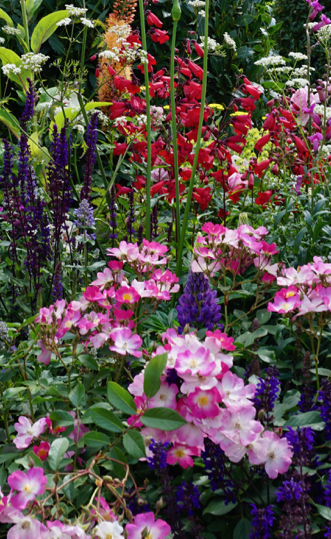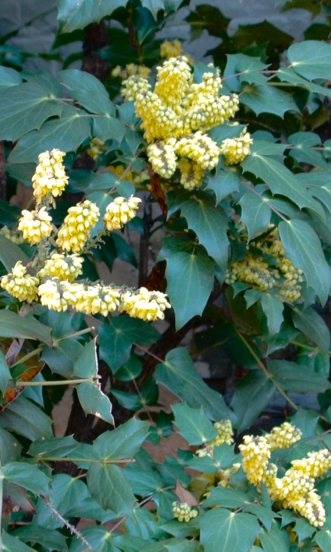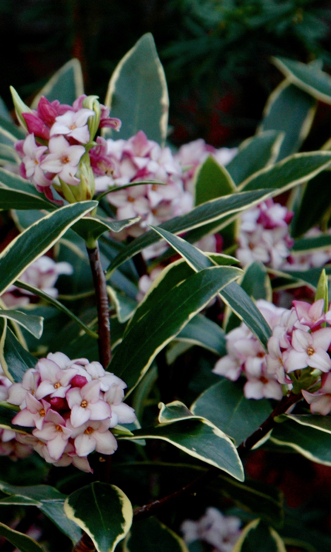The State of the Union


It’s that time of year again when the garden’s drab greens and browns are more than a little depressing. Ornamental cabbages and pansies are tired and worn looking, and most evergreens seem as though they are gasping for a warming sun and longer days. A sad state of affairs. A little like the state of the union? Perhaps it’s best to leave sleeping dogs lie.
Garden catalogues and magazines are somewhat cheering but this year they are not enough to get me out of a mid-winter funk. Playing hooky from obligations and chores, I found myself flipping through my garden photos instead, trying to find the most colorful garden I’ve photographed in the last year.
I knew what I was looking for so it didn’t take long to find it. It was an award-winning exhibition garden I saw at the Chelsea Garden Show last May built by the Irish garden designer, Diarmuid Gavin. Sponsored by Harrods, his design was quirky, even gimmicky as the garden was populated with topiary that, every fifteen minutes, began to rise, twirl and bob, lifted by unseen levers and computerized pulleys, as a pair of mechanized pruners seemed to sheer a revolving tree. Adding to the visual cacophony of moving parts was an actual band playing an English folk song.

The special effects were not what I found memorable, however. What stuck in my mind was Gavin’s bold color choices and textures.
In theory, there were two planting schemes though one seemed to flow into the other. The first included white, orange, chartreuse, pink, and yellow perennials interspersed by clipped boxwoods – and the dancing topiary. I especially loved the way the plumy orange-creamsicle colored foxtail lilies (Eremus ruiter “Pinocchio”) punctuated the beds as they stood just above many of the surrounding flowers. With good sun exposure and well-drained soil these tall, elegant, spring-blooming perennials are supposedly easy to grow and will even naturalize. Even better, they also come in white, soft pink, and a sweet soft yellow.

I also loved a more classic fusion of chartreuse euphorbias with fuchsia beardtongue (Penstemon “Garnet”). Penstemons are native to the US and thrive in full sun and medium dry soil. They also attract bees and hummingbirds and bloom from summer to fall. They wouldn’t normally bloom at the same times as foxtail lilies, but it’s Chelsea, where a little artistic license, like combining spring and summer blooming perennials, is a good thing.
Gavin’s second planting scheme was stronger still – a combination of sapphire blues, rosy pinks, regal purples, cerise reds, and lemony yellows. It sounds gaudy and so it was, but tasteful just the same. Combining red and blue salvias with pink shrub roses is a trick that I’m not sure I could pull off but somehow it worked in this eccentric garden.
Looking at my photos was definitely cheering. It’s hard to look at pleasing images and stay somber but the question remained: How to make my garden colorful enough in deep winter to avoid these mid-winter blues?

As it happens, my garden has become quite shady over the past couple of years, presenting me with an opportunity to replace roses and other plants that no longer bloom with plants that make winter seem brighter and still complement summer flowers. I’ve long wanted to plant Oregon grape-holly (Mahonia aquifolium), a plant I grew up with in the Pacific Northwest. It’s sharp, spikey dark green leaves will serve as a contrast to my camellias and ivy, and its late-winter racemes of small round cadmium yellow flowers will brighten any winter day. The blue berries that follow won’t be especially noticeable, but they will nourish birds like the cedar waxwing.

The mahonia’s flowers will look especially good with the variegated euphorbias (Euphorbia x martini) I planted last summer because their cheery narrow leaves are edged with creamy gold and tinged with just a hint of copper. I really love this euphorbia because constantly catches my eye. I didn’t plant enough of it, however, so I think I’ll planted a good deal more. I have a feeling that they could be stunning if combined with purple crocuses and crisp, white snow-drops and I’m looking forward to their lime green flowers in late spring.
And my final addition will probably be winter daphne (Daphne odora ‘Aureomarginata’).

Its leaves are also tinged with a creamy yellow and will complement both the yellow mahonia and euphorbia. It’s small clusters of tiny rose-colored flowers, which emerge in early spring, are deliciously fragrant which is another reason to plant them – there is nothing like it’s perfume on a warm early spring day. Unfortunately, daphnes are notoriously fussy, but it’s worth the effort of trying to make them happy by keeping them moist but not wet, and making sure they are sufficiently mulched and kept out of full sun.
Variegated leaves, of course, fall far short of the color feast in the Gavin’s display garden, but will improve the looks of my winter garden significantly and should help minimize those winter blues.
If only fixing the state of our union was as simple ...




